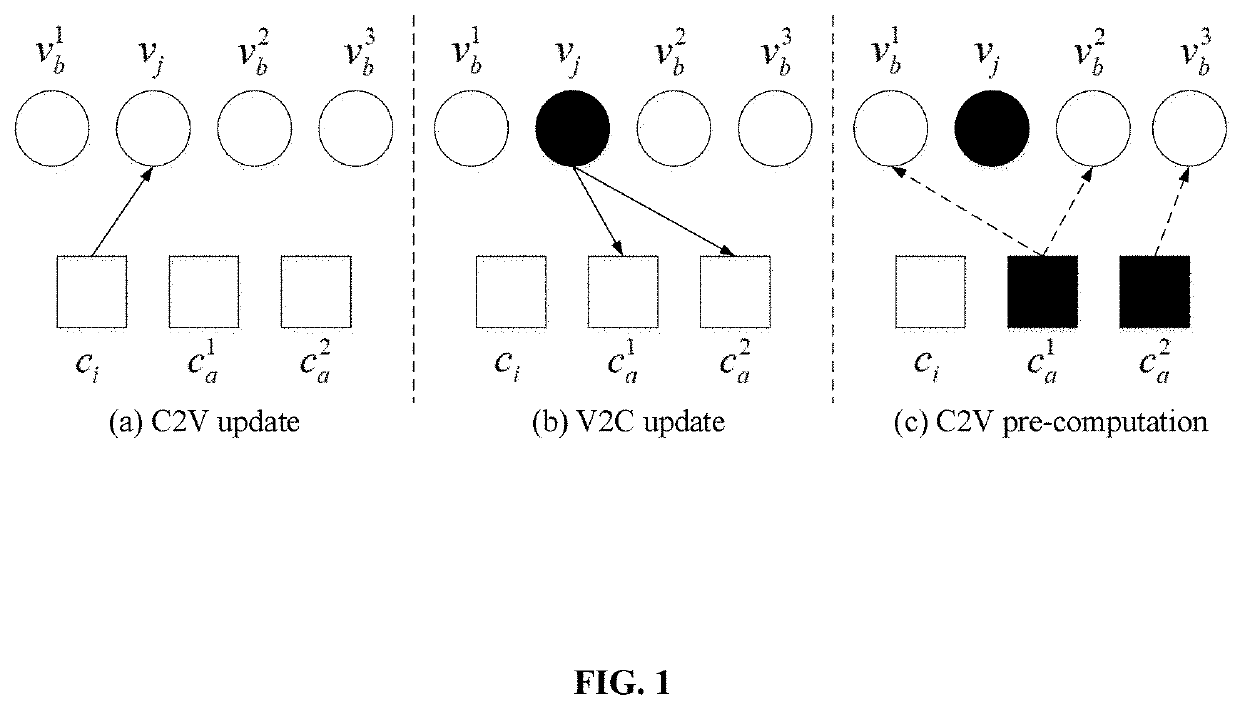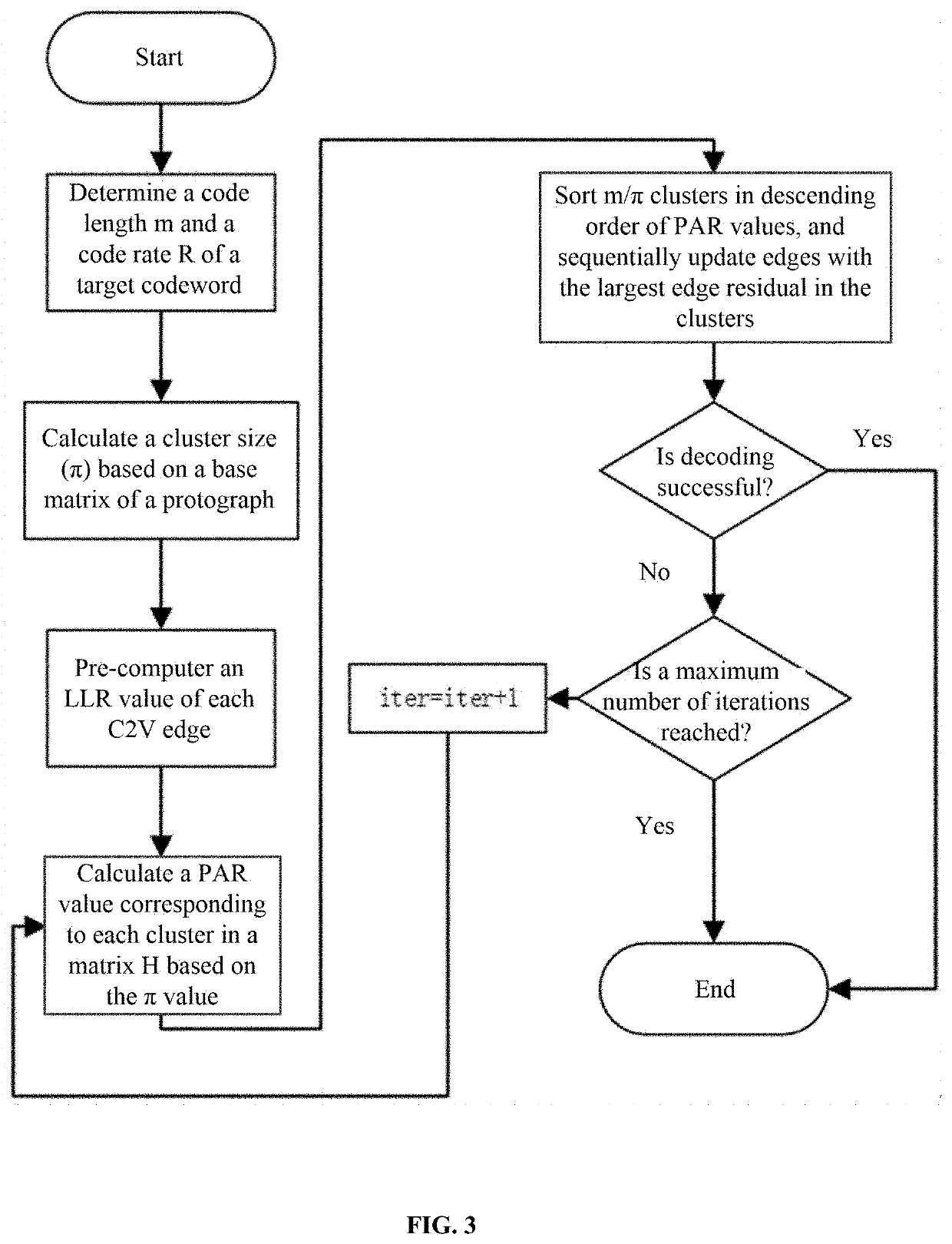Decoding method of LDPC codes based on partial average residual belief propagation
a residual belief and ldpc technology, applied in the field of communication technologies, can solve the problems of greediness becoming more obvious, the decoding performance of the decoding algorithm cannot be further improved, and the error correction performance is far inferior to the soft decision decoding algorithm
- Summary
- Abstract
- Description
- Claims
- Application Information
AI Technical Summary
Benefits of technology
Problems solved by technology
Method used
Image
Examples
embodiment 1
[0039]In this embodiment, a corresponding check matrix can be obtained by lifting a base matrix based on a structural characteristic of a protograph. The following is an example:
H=[π 00π010π 030π 11π 120π 200π 220](2)
wherein πij is a unit permutation matrix or its right-shift matrix, that is, a cluster.
[0040]FIG. 2 shows a Tanner graph after expansion of the protograph in the above example, where vi is a variable node of the base matrix, and cj is a check node of the base matrix.
[0041]Combined with the Tanner graph structural characteristics of the base matrix shown in FIG. 2, this embodiment provides a decoding method of LDPC codes based on partial average residual belief propagation (PARBP). As shown in FIG. 3, the method includes the following steps.
[0042]S1: Calculate a size of a cluster it in a protograph based on a code length m and a code rate of a target codeword. A calculation formula is as follows:
π=m÷bv (2)
wherein bv is a number of variable nodes in the base matrix.
[0...
embodiment 2
[0057]A computer system is provided, including a memory, a processor, and a computer program stored in the memory and executable on the processor, where the processor implements the following method steps when executing the computer program:
[0058]S1: calculating the size π of a cluster of a base matrix in a protograph based on a code length m and a code rate of a target codeword:
[0059]S2: pre-computing an edge residual rci→vj corresponding to each edge from a variable node to a check node in a check matrix H, where the check matrix H is obtained by lifting the base matrix based on a structural characteristic of the protograph;
[0060]S3: calculating, based on π, a PAR value corresponding to each cluster in the check matrix H;
[0061]S4: sorting m / π clusters in descending order of corresponding PAR values, and updating an edge with a largest edge residual in each cluster;
[0062]S5: updating edge information mci→vj from a check node ci to a variable node vj, and then updating an LLR value ...
embodiment 3
[0064]A computer-readable storage medium storing a computer program is provided, where the following method steps are implemented when the computer program is executed by a processor:
[0065]S1: calculating the size π of a cluster of a base matrix in a protograph based on a code length m and a code rate of a target codeword:
[0066]S2: pre-computing an edge residual rci→vj corresponding to each edge from a variable node to a check node in a check matrix H, where the check matrix H is obtained by lifting the base matrix based on a structural characteristic of the protograph;
[0067]S3: calculating, based on π, a PAR value corresponding to each cluster in the check matrix H;
[0068]S4: sorting m / π clusters in descending order of corresponding PAR values, and updating an edge with a largest edge residual in each cluster;
[0069]S5: updating edge information cci→vj from a check node ci to a variable node vj, and then updating an LLR value L(vj) of the variable node vj; and
[0070]S6: after the upda...
PUM
 Login to View More
Login to View More Abstract
Description
Claims
Application Information
 Login to View More
Login to View More - R&D Engineer
- R&D Manager
- IP Professional
- Industry Leading Data Capabilities
- Powerful AI technology
- Patent DNA Extraction
Browse by: Latest US Patents, China's latest patents, Technical Efficacy Thesaurus, Application Domain, Technology Topic, Popular Technical Reports.
© 2024 PatSnap. All rights reserved.Legal|Privacy policy|Modern Slavery Act Transparency Statement|Sitemap|About US| Contact US: help@patsnap.com










